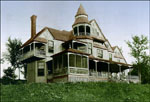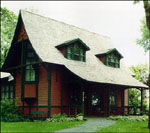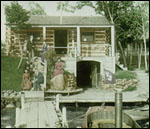MPR Newsroom
August 18, 1999
|
|
RealAudio 3.0 |
| |
|
|
|
| |
|
Fifty years ago most lake cabins were fishing shacks; uninsulated, unplumbed, and sometimes almost unreachable by road. Famously remote, they were also famously unsanitary, often dumping raw sewage straight into the water. Now there are more than 100,000 lake cabins in Minnesota, and while their environmental effects are rarely as obvious as an open sewer pipe, they may pose more subtle threats to clean water.
Part I: Lakeshore Development Has Historic Impact
By Leif Enger
HOWARD HAWKINS REMEMBERS Whitefish Lake in 1925. His family's home-built shack was the third to go up on Butternut Point, complete with two-hole outhouse - cutting-edge waste management in what was then a nearly roadless frontier.
Hawkins: My older brother Kent and I lived in a tent in front of the cabin for the first, oh, the first year. Cause there wasn't enough room. I mean, we started from scratch!
At 81, Hawkins still vacations in his now-much-larger cabin. Today he's got tons of neighbors; a small fleet of boats including jet skis for his grandchildren; and a motorized lift to get up and down the steep bank to the lake. Does he miss the old days?
Hawkins: No. My father was Norwegian, and by God he wanted that boat scraped and sanded and painted every damn year!
SFX: A big motor starting, muted belowdecks. a marine radio comes on: right now barometric pressure is 29.99, its sunny and 71 degrees ...
| |
|
|
|
||
Whitefish Lake, 1999. The definition of lake place has changed so much it almost needs a new dictionary. Rob Birkeland, a 27-year-old real estate agent in dress shoes and cotton weave, steers a 21-foot Sea Ray inboard along a row of magazine-cover summer homes.
Birkeland: A lake cabin today might be 2,000 - 3,000 square feet, several bedrooms, master bathrooms, vaulted ceilings, stone fireplaces ...
The story of shore development the past half century is one of continuous demand and dwindling supply. After World War II the lake place grew into a symbol of the good life accessible to the middle class. Its estimated there are now 130,000 lake cabins in Minnesota, a figure that doesn't include year-round lake homes. And sales are still brisk - even on the Whitefish Chain, where prime shoreline costs $2500 a foot.
Birkeland: They're coming seeing this area and they're saying, "You know if I was in upstate New York or California, a piece of property like this would be three times what it is here." So they come in with a whole different perspective than people from Minnesota.
| |
|
|
|
||
| |
||
Whitefish residents like to point out the aquamarine clarity of their lake. No more outhouses here; no more of the renowned cabin-to-lake sewer pipes some owners installed in the '40s and '50s. No more buried-Buick seepage pits. In fact, such disposal methods have violated state law since the 1930s, but those early rules were rarely enforced in places as remote as Brainerd. DNR hydrologist Dave Hills says it took the ecology movement of the 1960s to build concern about the effects of thousands of cabins crouched at waters' edge. When the state legislature passed tighter septic and setback regulations in 1971, Hills recalls, landowners didn't like it.
Hills: They immediately recognized there was a new sheriff in town, and they weren't happy with it. I recall a meeting right here in Brainerd, and another one in Wadena, in which threats were made. In the Wadena meeting, the DNR folks who were there did have their tires slashed, and had to call for help to get out of there.
On Whitefish Lake in 1962, a young schoolteacher named Erma Sentz bought a hundred feet of pristine shoreline in optimistically-named Ideal Township. She was widowed, with children. She wanted a place to spend summers.
Erma: My uncle, who'd done carpentry work in the area, had told me he'd build this cabin for me for a $1.50 an hour plus materials. Which was a good deal - even back then, a good deal!
Erma's uncle was not only a carpenter, but a conservationist who quietly imparted his cautious ethic to relatives and neighbors. The cabins he built are well back from the water. But his niece, now retired, says the lake suffers from development even when shoreline owners do everything right. On many lakes, the waterfront is only the first tier of construction, with blocks of residential and commercial properties stacked up behind.
Erma: It bothers me to see things just happen, without any kind of overall plan. I don't think growing is necessarily bad, but I think it can get bad quickly. Id like to have somebody prove me wrong on this, but I don't believe there's a long-range plan for that sort of building in Ideal Township.
| |
|
|
|
||
| |
||
In fact, the DNR says the watershed is the last thing many lake communities worry about when planning development. With the taxable value of lake properties more than doubling since 1995, local governments have incentive to encourage construction. But hydrologist Lonnie Thomas says the health of lakes depends on wise land use - even out of sight of water.
Lonnie: Wherever water falls, it has to find someplace to go. Parking lot runoff, waters routed through storm sewers; the storm sewer runs into the creek or ditch or the lake itself. Oil and gas in parking lots, animals in farmyards, salt on roads. If they have a route to the lake, they end up in the lake.
And increasingly, in lakes that never saw development before. On the swampy edge of Big Pine Lake, not farfrom Whitefish, John Overland dons leather chaps, bug repellent, and a quiver of pink plastic flags.
Overland: Looks like about 40 acres; about 15 residential lots, possibly eight commercial.
Overland is an environmental consultant based in Brainerd. He was hired by a contractor to mark exactly where the wetland begins, in preparation for construction on neighboring land. While Big Pine is by no means undeveloped, Overland says more and more often he's sent to prepare lakes that are.
Overland: The lots on the more highly desirable lakes are already utilized or in the process of being developed. And there's still a significant demand for lakefront property; so what's happened is it's now moving more toward the lakes that once were considered less desirable. Theones that were passed by in the first round are starting to get picked up.
The DNR says the factors that define lakes as second-round - weedy shorelines, warm shallows, and mucky bottoms - often make them richer in animal and plant life than their larger, more popular counterparts. While that can make for a more undiscovered setting-- a phrase favored by real estate firms - it also makes them more vulnerable to disruption.
Part II: Summer Visitors Put a Strain on Rural Communities
By Bob Reha
THE INFLUX OF SUMMER VISITORS brings economic benefits to small towns in the lake regions, but it also can strain city services. The town of Battle Lake, in Ottertail county in northwestern Minnesota, has a population of 710 in the winter months but thousands of visitors converge on the area
On a summer weekday morning Battle Lake Police chief Joe Jelmstad cruises around town on Highway 78. Jelmstad explains, when the weekend comes, these mostly empty streets are awash with people.
Jelmstad: On the busier weekends Highway 78 will be lined on both sides....uh Halvorson park here will be full ...Jelmstad desrcibes Battle Lake as a nice quiet town. Most communities of this size have maybe one police officer with a part time deputy. The math works a little better for Battle lake, but not much.
Jelmstad: We do carry as I said three full-time officers and that is year 'round and in the wintertime I joke with a lot of the people that that's two and a half too many in January and its about 15 too few in July ...Jelmstad's situtation is hardly unique.
Gary Nelson: Because of our 1048 lakes, the population jumps from around 55,000 to closer to 300,000 at times
| |
|
|
|
||
| |
||
Gary Nelson is Sheriff of Ottertail County. This population explosion puts a strain on a limited amount of resources.
Nelson: Like I say, 1048 lakes and we have about six water patrol deputies so that's about 170 lakes apiece, so you can imagine the problems they have trying to keep up with requests for assistance.In addition the department averages 17 911 calls a day and has over 2,000 miles of highway to patrol. To make sure that terroity gets covered, county officials like Nelson coordinate their efforts with local departments like Joe Jelmstad's
Jelmstad: The county is very good about helping us out, and we try to help them out as well; we back each other up, and we try to cover each other's behinds so that none of us is swinging in the breeze out here.The influx of summer visitors puts strains on other local services. Battle Lake's public works crew is preparing for a weekend arts festival. That means parks must be mowed, restrooms cleaned, and garbage picked up. It may not seem like much, but each weekend is like this. Crew member Steve Suefert says even the off-season is busy.
Suefert: The difference between summer and winter...winter we're fixin' and getting ready for next summer is basically what we do all winter, besides a little snow removal and that ...Which all costs money - just like the law enforcement - and year-round Battle Lake residents face other challenges, too.
Battle Lake's main street looks very healthy. There are several restaurants, gas stations, and a bait shop, of course. Milt Kopet owns the local hardware store. Kopet says local businesses are happy to have the influx of people, it's a problem that many small towns in the throes of the agriculture crisis wish they had.
Kopet: The only drawback on that side is that each year is that you're hiring people you have to hire new to train, and they're only seasonal for a short period of time, and if it was all year around you'd be able to keep those people in place. So for people working or jobs it's hard because it's work real hard lot of hours, and then no work at all.
| |
|
|
|
||
| |
||
Scotty Pedersons: Higher prices in the summertime.Wanda Berg is city clerk and treasurer for the city of Battle Lake. Berg says Battle Lake is typical of most small towns in lake country, how to fund services for thousands of people on a year-round tax base of 710 people. Like most areas of the country, the idea of increasing or creating new taxes to pay for services is not popular. City officials use everything available to them to keep costs down. Community service labor, federal grants, and volunteers. The city has even started its own business to create revenue.
Ken Pedersons: Yeah, it seems like prices go up a little bit in the summertime, especially gas, but that's all over…
Wanda Berg: However the profits from those businesses do not necessarily translate into higher taxes or more taxes collected for us.
A city worker rambles around an open lot. He carries a long, yellow, wand-like tool that resembles a cattle prod. The magnetic locator is being used to find survey stakes for Battle Lake's new municipal liquor store. City treasurer Wanda Berg.
Berg: And it's probably the one way that tourist dollars are directly filtered into the public coffers in the absence of a city sales tax or that type of thing. It's the one way that actually tourist dollars pay for some of the services that have to be provided.Berg says no one seems to mind that the city is in the liquor business. Most people find it a better alternative to increasing local taxes to pay for services, especially since property taxes in Ottertail County have increased by an average of 6.6 percent each year since 1990. But not all communities have this option. For those towns that can't start their own businesses or generate additional tax revenues visitors looking for a summer on the lake are becoming an expensive proposition with no relief in sight.





